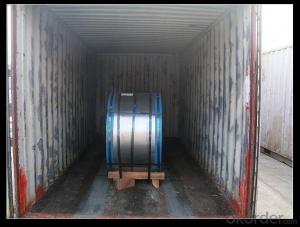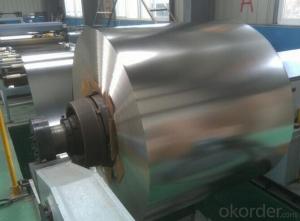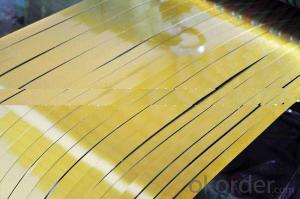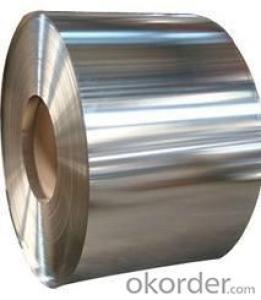Electrolytic Tinplate in Coils for Food Cans Packing
- Loading Port:
- Tianjin
- Payment Terms:
- TT OR LC
- Min Order Qty:
- 25 m.t
- Supply Capability:
- 7000 m.t/month
OKorder Service Pledge
OKorder Financial Service
You Might Also Like
1.Structure of Electrolytic Tinplate in Coils for Food Cans Packing Description
Electrolytic Tin Plate Coils and Sheets for Foods Metal Packaging, is one thin steel sheet with a coating of tin applied by electrolytic deposition. Tinplate made by this process is essentially a sandwich in which the central core is strip steel. This core is cleaned in a pickling solution and then fed through tanks containing electrolyte, where tin is deposited on both sides. As the strip passes between high-frequency electric induction coils, it is heated so that the tin coating melts and flows to form a lustrous coat.
2.Main Features of the Electrolytic Tinplate in Coils for Food Cans Packing
Appearance – Electrolytic Tin Plate is characterized by its beautiful metallic luster. Products with various kinds of surface roughness are produced by selecting the surface finish of the substrate steel sheet.
Paintability and printability – Electrolytic Tin Plates have excellent paintability and printability. Printing is beautifully finished using various lacquers and inks.
Formability and strength – Electrolytic Tin Plates have got very good formability and strength. By selecting a proper temper grade, appropriate formability is obtained for different applications as well as the required strength after forming.
Corrosion resistance – Tinplate has got good corrosion resistance. By selecting a proper coating weight, appropriate corrosion resistance is obtained against container contents. Coated items should meet 24 hour 5 % salt spray requirement.
Solderability and weldability – Electrolytic Tin Plates can be joined both by soldering or welding. These properties of tinplate are used for making various types of cans.
Hygienic – Tin coating provides good and non toxic barrier properties to protect food products from impurities, bacteria, moisture, light and odours.
Safe – Tinplate being low weight and high strength makes food cans easy to ship and transport.
Eco friendly – Tinplate offers 100 % recyclability.
Tin is not good for low temperature applications since it changes structure and loses adhesion when exposed to temperatures below – 40 deg C.
3.Electrolytic Tinplate in Coils for Food Cans Packing Images
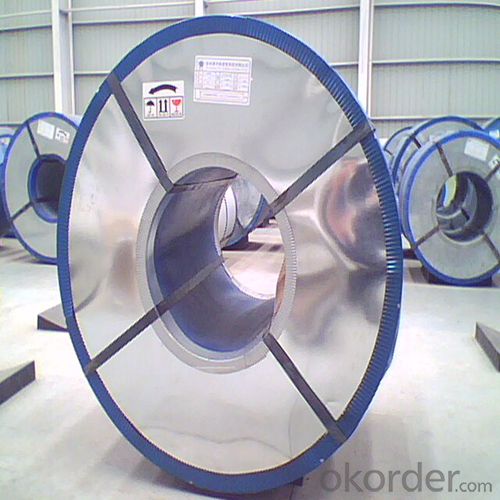

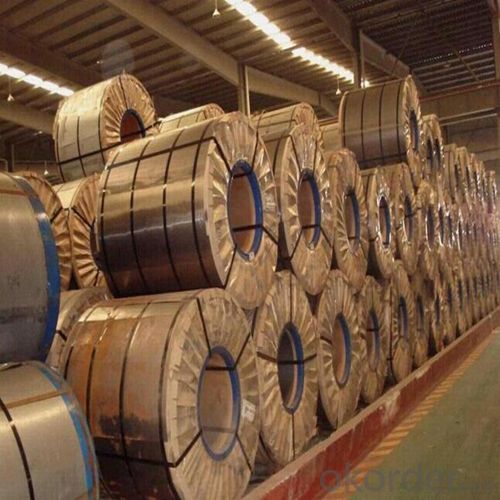
4.Electrolytic Tinplate in Coils for Food Cans Packing Specification
Standard | ISO 11949 -1995, GB/T2520-2000,JIS G3303,ASTM A623, BS EN 10202
|
Material | MR,SPCC |
Thickness | 0.15mm - 0.50mm |
Width | 600mm -1150mm |
Temper | T1-T5 |
Annealing | BA & CA |
Coil Inner Diameter | 508mm |
Weight | 6-10 tons/coil 1~1.7 tons/sheets bundle |
Passivation | 311 |
Oil | DOS |
Surface | Finish,bright,stone,matte,silver |
5.FAQ of Electrolytic Tinplate in Coils for Food Cans Packing
-How to place .an order or contact you ?
Please send us Email. we will give you a quick response in seconds .
- How is your quality ?
All our quality is prime even the secondary quality . We have many years experience
In this field with serious quality control standard . Advanced equipment, We welcome your visit to our factory .
- Q:What are the different ways to customize tinplate packaging?
- There are several ways to customize tinplate packaging. Some common methods include printing or embossing designs or logos directly onto the tinplate, applying decals or labels, using different colors or finishes, adding metallic or matte effects, and incorporating additional elements like windows or handles. These customization options allow businesses to create unique and visually appealing tinplate packaging that aligns with their brand identity and stands out on the shelves.
- Q:How does tinplate perform in terms of light blocking properties?
- Tinplate offers excellent light blocking properties due to its opaque and reflective surface, resulting in minimal light transmission.
- Q:Can tinplate be used in extreme temperatures?
- Yes, tinplate can be used in extreme temperatures. It is known for its excellent resistance to high and low temperatures, making it suitable for various applications in extreme environments.
- Q:What are the different methods of opening tinplate containers?
- There are several methods of opening tinplate containers, including using a can opener, a key opener, a pull tab, or by twisting off a screw cap lid.
- Q:Can tinplate be used for pharmaceutical packaging?
- Yes, tinplate can be used for pharmaceutical packaging. Tinplate is commonly used for packaging various products, including pharmaceuticals, due to its durability, resistance to corrosion, and ability to provide a protective barrier against light, moisture, and oxygen, which helps maintain the quality and shelf life of pharmaceutical products.
- Q:Can tinplate be used for industrial containers?
- Yes, tinplate can be commonly used for industrial containers due to its strength, durability, and resistance to corrosion.
- Q:How is tinplate stored and handled?
- Tinplate is typically stored in a dry and well-ventilated area to prevent rusting. It should be protected from moisture, direct sunlight, and extreme temperatures. When handling tinplate, it is important to wear gloves to avoid fingerprints and potential damage. It should be lifted carefully using appropriate equipment and stored in a manner that prevents scratching or bending.
- Q:How does tinplate compare to plastic in terms of sustainability?
- Tinplate generally has a higher sustainability profile compared to plastic due to several reasons. Firstly, tinplate is a highly recyclable material, with a recycling rate of around 90%, while plastic recycling rates vary and are generally lower. This means that tinplate is more likely to be reused and diverted from landfills, reducing its environmental impact. Additionally, tinplate production requires significantly less energy and emits fewer greenhouse gases compared to plastic manufacturing. Moreover, tinplate is more durable and has a longer lifespan, making it suitable for multiple uses, whereas plastic is often single-use and contributes to the growing waste problem. Overall, tinplate offers better sustainability prospects in terms of recycling, energy consumption, and durability compared to plastic.
- Q:What are the main applications of tinplate in the paint industry?
- Tinplate is commonly used in the paint industry for packaging purposes. It is primarily used for manufacturing paint cans, which provide a durable and protective container for storing paint products. Tinplate cans also offer excellent resistance to corrosion and airtight sealing, ensuring the longevity and quality of the paint. Additionally, tinplate cans are easy to handle, stack, and transport, making them a convenient choice for the paint industry.
- Q:How does tinplate packaging contribute to product convenience for consumers?
- Tinplate packaging contributes to product convenience for consumers in several ways. Firstly, tinplate is lightweight yet durable, making it easy to handle and carry. This ensures that consumers can transport the products conveniently without worrying about breakage or leakage. Secondly, tinplate packaging often comes with easy-to-open lids or pull-tabs, allowing for quick and hassle-free access to the contents. This saves time and effort for consumers, especially when compared to other packaging materials that may require tools or additional steps to open. Additionally, tinplate packaging provides excellent protection against moisture, light, and air, preserving the quality and freshness of the product for a longer shelf life. This convenience is highly valued by consumers as it ensures that the product remains intact and enjoyable till its expiration date.
1. Manufacturer Overview |
|
|---|---|
| Location | |
| Year Established | |
| Annual Output Value | |
| Main Markets | |
| Company Certifications | |
2. Manufacturer Certificates |
|
|---|---|
| a) Certification Name | |
| Range | |
| Reference | |
| Validity Period | |
3. Manufacturer Capability |
|
|---|---|
| a)Trade Capacity | |
| Nearest Port | |
| Export Percentage | |
| No.of Employees in Trade Department | |
| Language Spoken: | |
| b)Factory Information | |
| Factory Size: | |
| No. of Production Lines | |
| Contract Manufacturing | |
| Product Price Range | |
Send your message to us
Electrolytic Tinplate in Coils for Food Cans Packing
- Loading Port:
- Tianjin
- Payment Terms:
- TT OR LC
- Min Order Qty:
- 25 m.t
- Supply Capability:
- 7000 m.t/month
OKorder Service Pledge
OKorder Financial Service
Similar products
New products
Hot products
Hot Searches
Related keywords

